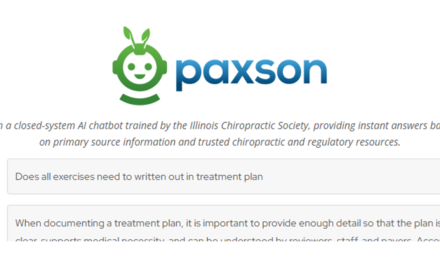
Claim Form Storytelling for CMT and E/M
Editor’s Note: The ICS has an on-demand course with Dr. Gwilliam covering the entire -25 modifier issue and all of the tips here.
Learn how to avoid 25 modifier denials by telling the right story on your claim form. Dr. Gwilliam explains diagnosis pointing, external cause codes, and tips to separate E/M and CMT services correctly.
Referenced Links:
E/M and CMT Bundling Prevention Toolkit
Paxson (ICS Trained AI)
Transcript:
Marc:
So, I’m back with Dr. Gwilliam this week, and we’re continuing our lengthy series and with a number of different videos. It was we’re talking about things that are rolled in with the E/M billed on the same dates of service as a CMT with a 25 modifier, and making sure that we’re getting paid for the services that you perform. And so one of the things we’ve talked about a bunch of different things, and we’re getting into the tips, into that nitty gritty, if you will, and the things that you need to know. But you’ll want to look at all of the videos, because it’s a lot of information. There’s a lot happening. But one of the things that we haven’t really touched on is telling the story up front. We want you on your claim form to tell the right story. One of the areas that we see is missed a lot is diagnosis pointing. We see it. We see it on the difference where a doctor who may be doing spinal adjustments, along with extremity adjustments and an E/M and maybe a modality, and at the end of the day, they just have their A through D, they just put, they put four diagnosis codes on their claim form and on every single one of those treatments they put Aa through D and including the extremity adjustments, giving it the exact same diagnosis as the spinal adjustment. And so the payers look at it and say, well, this, you can’t justify any of these services with the exact same conditions. It doesn’t make any sense. You’ve got to look at kind of this explanation on your claim form. The diagnosis codes are the explaining of why you’re doing those particular treatments. So when you have the exact same pointing for all of these different services, it doesn’t tell the right story. E/Ms are the same way. And so what we’re finding is that our doctors aren’t necessarily telling the right story on their claim form to give us the highest likelihood or the most reduced number of 25 bundled services, if you will. What are you seeing, Doc?
Dr. Gwilliam:
Yeah, you know, diagnosis pointing is a relatively easy fix. Ideally, the records already explain why you’re doing what you’re doing, but if you can communicate that through the codes again, you’re getting out in front of it. You don’t want them to have to ask for your records. You don’t want an audit that takes time. They have to put time into it. You have to put time into it. Nobody wants that. So you leverage what you have on the claim form, and you tell the story as much as possible. There are guidelines from payers that kind of help us understand this. When it comes to separating the E/M from the CMT, what we can do is point them to different diagnoses. So we explain the E/M was done for this diagnosis, and the CMT was done for this other one. And if we can tell them that, then they want to come back and look at the records. Fine, it’ll it’ll back that up. But that allows us to tell a more complete story without having to sit and read every line in the official record. The claim form captures the information through the codes.
Marc:
So, real quick, for argument’s sake, don’t the examination, diagnose, and the adjustment. Don’t they have to be exactly the same?
Dr.Gwilliam:
You know what? The guidelines say they can be the same. But our advice, and in our toolkit, we go deep dive into this is, you know what? Don’t let them be the same. The guidelines from different payers say, in order to get paid for an evaluation that’s separate from the CMT, you need to evaluate something beyond the CMT treatment. You have to evaluate something beyond. So we tell that by saying, Oh, I evaluated these other conditions the patient has. These other conditions that I’m not using to justify the chiropractic manipulative treatment. And so I would suggest that you do your CMT included exam to look at the subluxation diagnosis or segmental dysfunction, which is usually M 990, right? I mean, that’s what it is. And then you show them that your exam is separate by pointing it to a diagnosis of something else you’re evaluating, and whatever procedures you have to do to figure out if this other thing is also there an example of some, some ICD 10 codes that might be helpful would be other conditions, you know, like I’m going to evaluate the strain. I’m going to evaluate, you know, this degeneration, and you evaluate that on your separate page, as we talked about in another video. But we could go beyond that, too. There’s other ICD 10 codes you may not have known existed that are kind of helpful, and that’s our friend’s external causes.
So external cause codes are in chapter 20 of ICD-10, and they’re kind of the Forgotten stepchildren of ICD-10, because the guidelines tell us they’re optional. But here’s an option I’d like you to consider taking because external cost codes explain the circumstances that led to the need for a procedure. So what was going on? Where was the person? What were they doing? What happened? And examples might include they were driving a car when they were struck by a larger vehicle or they were walking down the hallway at a hospital. They were an example we put in our toolkit was they were out gardening, and there’s a code that says the patient was trimming bushes. There’s a code for that, so you could say what triggered the exam today. Why is there an exam? You could add the external cause code. The one we’re talking about is Y93.H2; Y93.H2 is the code for activity, gardening, and landscaping. So if the patient was gardening and landscaping, and it exacerbated their condition, and they had this, you know, they they’re they got worse, and you go, man, I need to examine this to figure out if I need to change things, if you want to make it clear that you’re doing a separate E/M, then you point the diagnosis to that Y93 code that tells them the exam is for this. You don’t point the adjustment, by the way, to that. You let the adjustment point to the M990, then you have the exam point to this external cause code that says what they were doing, and that shows that we’re doing an exam for some other purpose that had an exacerbation due to this activity they were engaged in. That story is so much more complete when we tell something like that.
Marc:
Yeah, and these things matter, right? So, as you mentioned a couple of them, but there are a lot of these codes. Incidentally, by the way, for ICS members, you can go into the members version of Paxson, our AI, has been fully trained on all things ICD-10 and so you can ask questions about what a particular code might be. Paxson can help you find some specific codes that may help with this. As example, recently, I ended up with a low back issue, and it required a bit more examination and a 25 modified exam by my chiropractic physician. And so what we found was, if he added in Y93.G3, I was actually leaning over and picking up some ribs that I was getting ready to put on the smoker, and ended up having a problem. It was a weird fluke thing, but by appending this Y93.G3, it explains why he’s doing the examination, why this is different than the previous adjustment that I had received earlier in the week. And so this additional explanation it matters, and it helps tell a more complete story.
Dr. Gwilliam:
Now, Marc, we’re all concerned about how you recovered, but I want to know, how did the ribs turn out?
Marc:
So the ribs were fantastic. Let’s be honest. They were actually very, very good. So yeah,
Dr. Gwilliam:
That’s the most important thing. And we hope that your provider was paid properly for that exam that was clearly warranted by the exacerbation. I hope you shared the ribs, too. We could go beyond, though; there are other codes too. Those are external cause codes that explain the circumstances. There’s also codes that you probably are unfamiliar with in chapter 21 of ICD-10, these are Z codes, and Z codes represent reasons for encounters. A lot of them are really useful for explaining why patients getting a routine wellness exam, for example. But if we look at them, we might be able to use them to clarify why we’re doing an exam in a chiropractic setting as well. For example, one of my favorites is Z09, it’s a short three-digit three-character code, and it’s encounter for follow-up exam after completed treatment for conditions other than a malignant neoplasm. So forget the malignant neoplasm. We’re doing something else. Encounter for follow-up exam. Well, that sounds like a classic chiropractic standard of care reevaluation to monitor progress, and it would help tell that story. So what we do on a claim form – I got one here. Maybe you can see it there in this column, right? Anyway, I got the claim form in the diagnosis pointer column right in the middle of the bottom half of the page. You would link your exam to Z09 to say, I’m doing this exam because it’s a follow-up exam after I completed treatment. This would be a trial period of care. This doesn’t mean you’re done. It doesn’t mean it’s a discharge exam. Necessarily. It means you’re at the end of a phase of care, and you might, based on the exam, determine you need to do more, but you at the very least, you have to justify and explain what you did and why it was helpful, and whether or not it worked, and whether or not the goals were reached. All of that is a clearly justifiable exam, in my opinion, that should be paid because you’re doing extra work, and that Z09 explains why. So you point it to the E/M service and not the CMT service.
Marc:
Yeah, and this is really important, because, as we talked about in a previous video, if we look at Blue Cross, Blue Shield, and even what they say in their chiropractic guidelines, and what they say should be paid and is appropriate, here’s the quote, and I said it in earlier video, but I’m going to say it again now, because I think it’s super important for what Dr. Gwilliam just touched on is examples of when it may be appropriate to bill an additional E/M service would be the evaluation of new patients, new injuries, exacerbations, which, by the way, we discovered in all the other ones, but the last one is this, or periodic reevaluations. So you drop the Z09 code on the exam, super important, not on the adjustment. And I think that’s important too. And I think you touched on that earlier, but when we’re adding these additional explainer codes, if you will, we’re not putting them on the adjustment. We’re explaining why we’re doing the examination. The condition is why you’re doing the CMT work; the explanation is why you’re actually performing the exam. In this case, the Z09 would be saying, Hey, I’m doing a periodic reevaluation, and that’s what you’re telling them. And you’re pointing to it, but you’re not pointing that Z09 to the adjustments. And that’s why diagnosis pointing is so important as well.
Dr. Gwilliam:
Let me throw this into the column you’re talking about is 24e on the claim form. That’s where the diagnosis pointing occurs. There’s space for four. You can list 12 diagnoses up in box 21, but down in 24e is where you can point to four of them. So maybe the CMT points to codes A and B, because they talk about spinal manipulation. And then the next few codes are C and D, and those are the ones that are listed in box 24e for the exam. I also want to toss back out a little shout-out to Paxson, and using Paxson for your ICD-10 search. I like to take credit for teaching Paxson all that she knows about ICD-10. I’ve been I became certified as an ICD-10 instructor, and I’ve been teaching ICD-10-related stuff for over a decade now. And you know now Paxson has all that knowledge, use that resource that you have access to, because, you know, she knows what she’s talking about.
Marc:
That’s and thank you, by the way, that he that everything you just said is absolutely true, and also just just so you know, Paxson has also been trained on all of these tools and tips and tricks, and so the toolkit Paxson has been trained on so you can have a conversation with Paxson and try to find out your best method for ensuring that you get paid moving forward too. But hopefully this information helps you out and make sure that you diagnosis point well, and then you separate these things and you add these different explaining codes. It’s going to help ensure that we’re telling the right story on the claim form, long before you have to go in and do any kind of a rebuttal or appeal to make sure later on, we want you to get paid up front without having to fight for the funds. Instead, just tell the story better up front, and we’ll catch you next week.

















